Accepted Scientific Name: Lithops lesliei C036A TL: Near Warrenton, South Africa cv. albinica D.T.Cole
Aloe 22 (3) 59-61, 1985
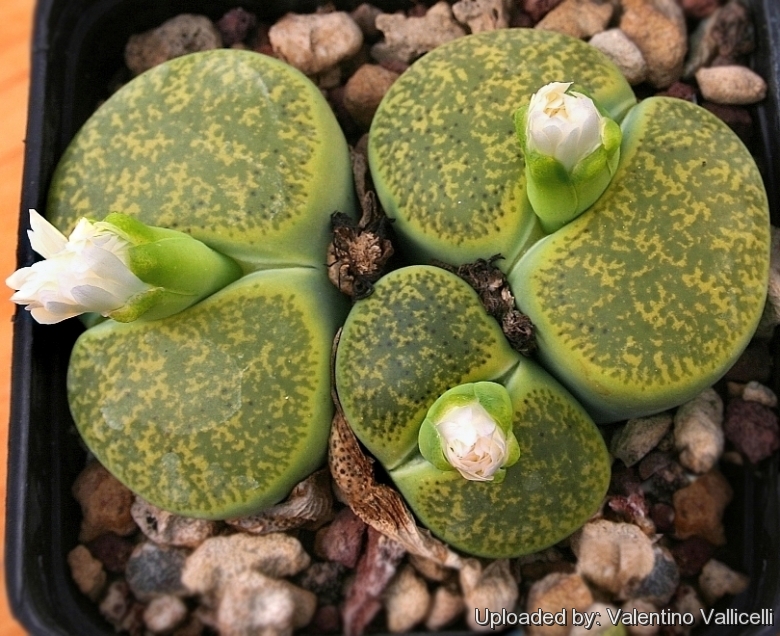
Lithops lesliei f. albinica (Lithops lesliei C036A TL: Near Warrenton, South Africa cv. albinica) Photo by: Valentino Vallicelli
Nice yellowish green body and top with fine intricate green pattern and white flowers.
Origin and Habitat: Type locality near Warrenton Northern Cape South Africa.
Synonyms:
See all synonyms of Lithops lesliei
back
Accepted name in llifle Database:Lithops lesliei (N.E.Br.) N.E.Br.Gard. Chron. 1922, Ser. III. lxxi. 65.Synonymy: 59
- Lithops lesliei (N.E.Br.) N.E.Br.
- Lithops lesliei var. applanata (N.E.Br.) N.E.Br.
- Lithops lesliei subs. burchellii D.T.Cole
- Lithops lesliei subs. burchellii C302 TL: 20 km NNE of Douglas, South Africa
- Lithops lesliei subs. burchellii C308 10 km NNE of Douglas, South Africa
- Lithops lesliei C005 TL: (Warrenton Form) Near Warrenton, South Africa
- Lithops lesliei C007 15 km S of Johannesburg, South Africa
- Lithops lesliei C008 (grey Form) 70 km W of Mafikeng, South Africa
- Lithops lesliei C009 (grey Form) 70 km W of Mafikeng, South Africa
- Lithops lesliei C010 25 km SW of Lobatse, Botswana
- Lithops lesliei C014 (Kimberley Form) 15 km NW of Kimberley, South Africa
- Lithops lesliei C018 Near Stella, South Africa
- Lithops lesliei C020 (syn. luteoviridis) TL: 15 km W of Magaliesburg, South Africa
- Lithops lesliei C026 60 km SW of Johannesburg, South Africa
- Lithops lesliei C027 Near Bethlehem, South Africa
- Lithops lesliei C028 10 km N of Harrismith, South Africa
- Lithops lesliei C029 45 km NE of Vaalwater, South Africa
- Lithops lesliei C030 (Pietersburg Form) 30 km NW of Pietersburg, South Africa
- Lithops lesliei C031 10 km NE of Meyerton, South Africa
- Lithops lesliei C032 (Pietersburg Form) 10 km SE of Pietersburg, South Africa
- Lithops lesliei C033 45 km E of Pietersburg, South Africa
- Lithops lesliei C036 (Warrenton Form) Near Warrenton, South Africa
- Lithops lesliei C096 (Warrenton Form) 25 km N of Kimberley, South Africa
- Lithops lesliei C115 5 km NW of Vryburg, South Africa
- Lithops lesliei C138 Near Benoni, South Africa
- Lithops lesliei C139 5 km E of Benoni, South Africa
- Lithops lesliei C151 (grey Form) 25 km NW of Christiana, South Africa
- Lithops lesliei C331 15 km SSE of Pretoria, South Africa
- Lithops lesliei C341 (Kimberley Form) 20 km NW of Kimberley, South Africa
- Lithops lesliei C342 10 km NE of Pretoria, South Africa
- Lithops lesliei C343 Near Vanderbijlpark, South Africa
- Lithops lesliei C344 Near Orkney, South Africa
- Lithops lesliei C352 45 km E of Pietersburg, South Africa
- Lithops lesliei C354 (Kimberley Form) 15 km NW of Kimberley, South Africa
- Lithops lesliei C358 25 km W of Lobatse, Botswana
- Lithops lesliei C359 (grey Form) 115 km SW of Lobatse, Botswana
- Lithops lesliei C407 15 km N of Krugersdorp, South Africa
- Lithops lesliei var. hornii de Boer
- Lithops lesliei var. hornii C015 40 km SW of Kimberley, South Africa
- Lithops lesliei var. hornii C364 TL: 45 km SSW of Kimberley, South Africa
- Lithops lesliei var. maraisii de Boer
- Lithops lesliei var. mariae D.T.Cole
- Lithops lesliei var. mariae C141 TL: 10 km SW of Boshof, South Africa
- Lithops lesliei var. mariae C152 30 km NNE of Kimberley, South Africa
- Lithops lesliei var. minor de Boer
- Lithops lesliei var. minor C006 TL: 25 km SW of Swartruggens, South Africa
- Lithops lesliei var. rubrobrunnea de Boer
- Lithops lesliei var. rubrobrunnea C017 TL: 5 km NW of Randfontein, South Africa
- Lithops lesliei var. rubrobrunnea C204 5 km NW of Krugersdorp, South Africa
- Lithops lesliei var. venteri (Nel) de Boer & Boom
- Lithops lesliei var. venteri C001 30 km NW of Warrenton, South Africa
- Lithops lesliei var. venteri C047 TL: 30 km W of Warrenton, South Africa
- Lithops lesliei var. venteri C153 (syn. maraisii) TL: 60 km NW of Kimberley, South Africa
Cultivars
(8):
back
Description: White flowering + green bodied form.
Subspecies, varieties, forms and cultivars of plants belonging to the Lithops lesliei group
 Lithops lesliei (N.E.Br.) N.E.Br.: (var. lesliei) Cole numbers: C014, C020, C028, C036, C026, C151, C344, C352, C358. Deep rusty brown with brown windows; flowers golden yellow.
Lithops lesliei (N.E.Br.) N.E.Br.: (var. lesliei) Cole numbers: C014, C020, C028, C036, C026, C151, C344, C352, C358. Deep rusty brown with brown windows; flowers golden yellow. Lithops lesliei subs. burchellii D.T.Cole: Cole number(s):C302, C308. Distinguished from subsp. lesliei by colour and markings, and from var. venteri by the much finer meshlike markings and clavate marginal lines. Origin: RSA: CP, in small area NE of Douglas. It is probable that this subspecies occurs also in the military zone further to the NE, along the Vaal River.
Lithops lesliei subs. burchellii D.T.Cole: Cole number(s):C302, C308. Distinguished from subsp. lesliei by colour and markings, and from var. venteri by the much finer meshlike markings and clavate marginal lines. Origin: RSA: CP, in small area NE of Douglas. It is probable that this subspecies occurs also in the military zone further to the NE, along the Vaal River. Lithops lesliei subs. burchellii C302 TL: 20 km NNE of Douglas, South Africa: highly branched lines.
Lithops lesliei subs. burchellii C302 TL: 20 km NNE of Douglas, South Africa: highly branched lines. Lithops lesliei subs. burchellii C308 10 km NNE of Douglas, South Africa: beautiful form.
Lithops lesliei subs. burchellii C308 10 km NNE of Douglas, South Africa: beautiful form. Lithops lesliei C005A TL: Near Warrenton, South Africa cv. albiflora D.T.Cole: Extremely rare white flowering form, occasionally found in any one colony, but in all other respects the plants are indistinguishable from others in the same colony. They can therefore be identified only when in flower.
Lithops lesliei C005A TL: Near Warrenton, South Africa cv. albiflora D.T.Cole: Extremely rare white flowering form, occasionally found in any one colony, but in all other respects the plants are indistinguishable from others in the same colony. They can therefore be identified only when in flower. Lithops lesliei C005 TL: (Warrenton Form) Near Warrenton, South Africa: brown spotted window.
Lithops lesliei C005 TL: (Warrenton Form) Near Warrenton, South Africa: brown spotted window.- Lithops lesliei C007 15 km S of Johannesburg, South Africa: green bronze top.
- Lithops lesliei C008 (grey Form) 70 km W of Mafikeng, South Africa
- Lithops lesliei C009 (grey Form) 70 km W of Mafikeng, South Africa: rusty grey, jagged.
- Lithops lesliei C010 25 km SW of Lobatse, Botswana: lacy windows.
 Lithops lesliei C014 (Kimberley Form) 15 km NW of Kimberley, South Africa: transparent veined network.
Lithops lesliei C014 (Kimberley Form) 15 km NW of Kimberley, South Africa: transparent veined network. Lithops lesliei C018 Near Stella, South Africa
Lithops lesliei C018 Near Stella, South Africa- Lithops lesliei C020 (syn. luteoviridis) TL: 15 km W of Magaliesburg, South Africa: mysterious green shades.
 Lithops lesliei C026 60 km SW of Johannesburg, South Africa: rusty pink, olive green windows.
Lithops lesliei C026 60 km SW of Johannesburg, South Africa: rusty pink, olive green windows.- Lithops lesliei C027 Near Bethlehem, South Africa: blue grey body, clear green windows.
- Lithops lesliei C028 10 km N of Harrismith, South Africa: brown background, jagged green veins.
 Lithops lesliei C029 45 km NE of Vaalwater, South Africa: dark rusty, olive-green-pink window.
Lithops lesliei C029 45 km NE of Vaalwater, South Africa: dark rusty, olive-green-pink window.- Lithops lesliei C030 (Pietersburg Form) 30 km NW of Pietersburg, South Africa: windows of opportunity.
 Lithops lesliei C031 10 km NE of Meyerton, South Africa: dark green windows.
Lithops lesliei C031 10 km NE of Meyerton, South Africa: dark green windows. Lithops lesliei C032 (Pietersburg Form) 10 km SE of Pietersburg, South Africa: pinkish grey.
Lithops lesliei C032 (Pietersburg Form) 10 km SE of Pietersburg, South Africa: pinkish grey. Lithops lesliei C033 45 km E of Pietersburg, South Africa: pale green grey, very nice pattern.
Lithops lesliei C033 45 km E of Pietersburg, South Africa: pale green grey, very nice pattern. Lithops lesliei C036 (Warrenton Form) Near Warrenton, South Africa: rusty tinge.
Lithops lesliei C036 (Warrenton Form) Near Warrenton, South Africa: rusty tinge. Lithops lesliei C036A TL: Near Warrenton, South Africa cv. albinica D.T.Cole: Distinctly translucent, grass green to yellowish sheen with yellow lines and patches. White flowers. Known only from one locality, CP.
Lithops lesliei C036A TL: Near Warrenton, South Africa cv. albinica D.T.Cole: Distinctly translucent, grass green to yellowish sheen with yellow lines and patches. White flowers. Known only from one locality, CP. Lithops lesliei C036B Near Warrenton, South Africa cv. Storms Albinigold D.T.Cole: Distinctly translucent, grass green to yellowish sheen with yellow lines and patches with rich yellow flowers. It is indistinguishable from acf 'Albinica'. It can therefore be identified only when in flower.
Lithops lesliei C036B Near Warrenton, South Africa cv. Storms Albinigold D.T.Cole: Distinctly translucent, grass green to yellowish sheen with yellow lines and patches with rich yellow flowers. It is indistinguishable from acf 'Albinica'. It can therefore be identified only when in flower. Lithops lesliei C096 (Warrenton Form) 25 km N of Kimberley, South Africa
Lithops lesliei C096 (Warrenton Form) 25 km N of Kimberley, South Africa Lithops lesliei C115 5 km NW of Vryburg, South Africa: translucent green windows.
Lithops lesliei C115 5 km NW of Vryburg, South Africa: translucent green windows.- Lithops lesliei C138 Near Benoni, South Africa: opaque pink-green jagged window.
 Lithops lesliei C139 5 km E of Benoni, South Africa
Lithops lesliei C139 5 km E of Benoni, South Africa Lithops lesliei C151 (grey Form) 25 km NW of Christiana, South Africa: dark veined network.
Lithops lesliei C151 (grey Form) 25 km NW of Christiana, South Africa: dark veined network.- Lithops lesliei C331 15 km SSE of Pretoria, South Africa
- Lithops lesliei C341 (Kimberley Form) 20 km NW of Kimberley, South Africa: pale form.
 Lithops lesliei C342 10 km NE of Pretoria, South Africa: Chinese-red, nice.
Lithops lesliei C342 10 km NE of Pretoria, South Africa: Chinese-red, nice.- Lithops lesliei C343 Near Vanderbijlpark, South Africa: reddish, with tiny windows.
- Lithops lesliei C344 Near Orkney, South Africa
 Lithops lesliei C352 45 km E of Pietersburg, South Africa: coarse pale markings, distinctive.
Lithops lesliei C352 45 km E of Pietersburg, South Africa: coarse pale markings, distinctive. Lithops lesliei C354 (Kimberley Form) 15 km NW of Kimberley, South Africa: quite dark brown, lined.
Lithops lesliei C354 (Kimberley Form) 15 km NW of Kimberley, South Africa: quite dark brown, lined. Lithops lesliei C358 25 km W of Lobatse, Botswana: jagged markings.
Lithops lesliei C358 25 km W of Lobatse, Botswana: jagged markings.- Lithops lesliei C359 (grey Form) 115 km SW of Lobatse, Botswana: grey-brown surface.
- Lithops lesliei C407 15 km N of Krugersdorp, South Africa
- Lithops lesliei var. hornii de Boer: Cole numbers:C015, C364. Light ochre to rusty brown coloured body with greyish brown branching patterning. Yellow flowers. Endemic to a small area SW and S of Modderrivier.
 Lithops lesliei var. hornii C015 40 km SW of Kimberley, South Africa: jagged rusty brown window.
Lithops lesliei var. hornii C015 40 km SW of Kimberley, South Africa: jagged rusty brown window.- Lithops lesliei var. hornii C015A 40 km SW of Kimberley, South Africa cv. Greenhorn D.T.Cole
 Lithops lesliei var. hornii C364 TL: 45 km SSW of Kimberley, South Africa: rusty brown.
Lithops lesliei var. hornii C364 TL: 45 km SSW of Kimberley, South Africa: rusty brown.- Lithops lesliei var. mariae D.T.Cole: Cole numbers:C141, C152.Gold specled with clear, orangish body with many very fine, pinspots darker dots. Yellow flowers. Distribution: RSA: OFS, in a small area within the range of var. lesliei, to the W of Boshoff and N and NE of Kimberley.
 Lithops lesliei var. mariae C141 TL: 10 km SW of Boshof, South Africa: spattered, fine pattern.
Lithops lesliei var. mariae C141 TL: 10 km SW of Boshof, South Africa: spattered, fine pattern. Lithops lesliei var. mariae C152 30 km NNE of Kimberley, South Africa: fine speckles and lines.
Lithops lesliei var. mariae C152 30 km NNE of Kimberley, South Africa: fine speckles and lines.- Lithops lesliei var. minor de Boer: Cole numbers: C006. Yellow-brown to rusty brown, very similar to the typical form of var. lesliei, but consistently smaller and with slightly different markings. Yellow flowers. Distribution: RSA: Tvl, in a very small area to the SW of Swartruggens, thus within the range of var. lesliei.
 Lithops lesliei var. minor C006A 25 km SW of Swartruggens, South Africa cv. Witblom D.T.Cole: White flowering form. It is indistinguishable from the standar v. minor. It can therefore be identified only when in flower.
Lithops lesliei var. minor C006A 25 km SW of Swartruggens, South Africa cv. Witblom D.T.Cole: White flowering form. It is indistinguishable from the standar v. minor. It can therefore be identified only when in flower.- Lithops lesliei var. minor C006 TL: 25 km SW of Swartruggens, South Africa: dark window, rust body, small.
- Lithops lesliei var. rubrobrunnea de Boer: Cole numbers: C017, C204. Differs from the type variety mainly for the red brow colour. Distribution: RSA: Tvl, within the range of var. lesliei, in a very small area W of Randfontein and Krugersdorp.
 Lithops lesliei var. rubrobrunnea C017 TL: 5 km NW of Randfontein, South Africa: reddish grey body.
Lithops lesliei var. rubrobrunnea C017 TL: 5 km NW of Randfontein, South Africa: reddish grey body.- Lithops lesliei var. rubrobrunnea C204 5 km NW of Krugersdorp, South Africa: dark maroon top.
 Lithops lesliei var. venteri (Nel) de Boer & Boom: Cole numbers:C001, C047, C153. Grey body with grey black denticulate windows, like small worms. Yellow flowers. Distribution: RSA: CP, in a fairly narrow strip on both sides of the Harts River, extending NE from its confluence with the Vaal River near Delportshoop to a point near Taung.
Lithops lesliei var. venteri (Nel) de Boer & Boom: Cole numbers:C001, C047, C153. Grey body with grey black denticulate windows, like small worms. Yellow flowers. Distribution: RSA: CP, in a fairly narrow strip on both sides of the Harts River, extending NE from its confluence with the Vaal River near Delportshoop to a point near Taung. Lithops lesliei var. venteri C001 30 km NW of Warrenton, South Africa: grey-black top, intricate.
Lithops lesliei var. venteri C001 30 km NW of Warrenton, South Africa: grey-black top, intricate.- Lithops lesliei var. venteri C001 cv. Green form
 Lithops lesliei var. venteri C047 TL: 30 km W of Warrenton, South Africa: margin veined.
Lithops lesliei var. venteri C047 TL: 30 km W of Warrenton, South Africa: margin veined. Lithops lesliei var. venteri C153 (syn. maraisii) TL: 60 km NW of Kimberley, South Africa: grey or black apex.
Lithops lesliei var. venteri C153 (syn. maraisii) TL: 60 km NW of Kimberley, South Africa: grey or black apex.- Lithops lesliei cv. Fred´s Redhead
- Lithops lesliei cv. Vivid Green
Bibliography: Major refences and further lectures
1) Heidrun E. K. Hartmann “Aizoaceae F – Z” Springer 2002
2) Achim Hecktheuer “Mesembs, mehr als nur Lithops” Books on Demand GmbH Norderstedt. 2008
3) Desmond T. Cole & Naureen A. Cole, Uwe Beyer, Yves Delange “Les Lithops” SUCCULENTES Spécial 2008 AIAPS (now Terra seca). 2008
4) Desmond T. Cole & Naureen A. Cole “LITHOPS Flowering Stones” Cactus & Co. Libri. 2005
5) Yasuhiko Shimada “The Genus Lithops” Dobun Shoin. 2001
6) Rudolf Heine “Lithops - Lebende Steine” Neumann Verlag. 1986
7) Bernd Schlösser “Lithops – Lebende Steine” Praktische Anleitung für die Zimmerkultur. BussinessPoint MEDIA. 2000
8) Steven A. Hammer “Lithops – Treasures of the veld” British Cactus and Succulent Society. 1999
9) Desmond T. Cole “Lithops – Flowering Stones” Acorn Books 1988
10) Rudolf Heine “Lithops – lebende Steine” Neumann Verlag. 1986
11) David L. Sprechman “Lithops” Associated University Presses, Inc. 1970
12) Gert Cornelius Nel “Lithops” Hortors Limited, South Africa 1946
13) Edgar Lamb "The illustrated reference on cacti and other succulents" Blandford Press. 1978
14) Christopher Brickell, Royal Horticultural Society "RHS A-Z Encyclopedia of Garden Plants: K-Z., Volume 2" Kindersley, 2008
15) G. C . Nel “Lithops: Plantae succulantae, rarissimae, in terra obscuratae, e famailia Aizoaceae, ex Africa australi” Hortors Limited, Cape Town, South Africa 1946
16) Heidrun E. K. Hartmann "Illustrated Handbook of Succulent Plants: Aizoaceae F-Z" Springer, 2002
 Lithops lesliei f. albinica (Lithops lesliei C036A TL: Near Warrenton, South Africa cv. albinica) Photo by: K.k. Agrawal
Lithops lesliei f. albinica (Lithops lesliei C036A TL: Near Warrenton, South Africa cv. albinica) Photo by: K.k. Agrawal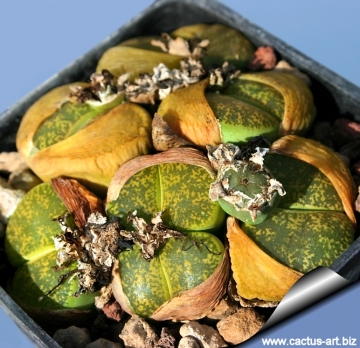 Lithops lesliei f. albinica (Lithops lesliei C036A TL: Near Warrenton, South Africa cv. albinica) Photo by: Cactus Art
Lithops lesliei f. albinica (Lithops lesliei C036A TL: Near Warrenton, South Africa cv. albinica) Photo by: Cactus Art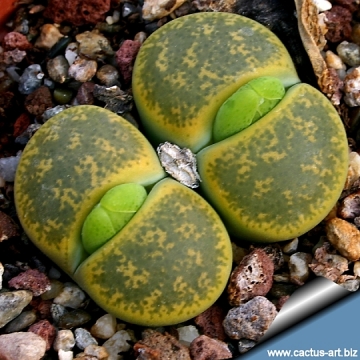 Lithops lesliei f. albinica (Lithops lesliei C036A TL: Near Warrenton, South Africa cv. albinica) Photo by: Cactus Art
Lithops lesliei f. albinica (Lithops lesliei C036A TL: Near Warrenton, South Africa cv. albinica) Photo by: Cactus Art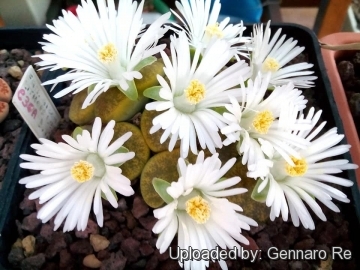 Lithops lesliei f. albinica (Lithops lesliei C036A TL: Near Warrenton, South Africa cv. albinica) Photo by: Gennaro Re
Lithops lesliei f. albinica (Lithops lesliei C036A TL: Near Warrenton, South Africa cv. albinica) Photo by: Gennaro Re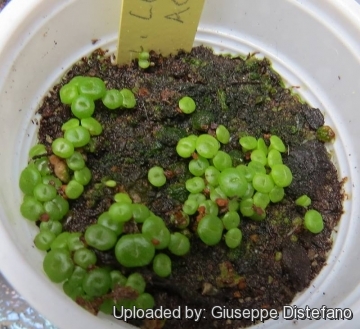 Seedlings. (Lithops lesliei C036A TL: Near Warrenton, South Africa cv. albinica) Photo by: Giuseppe Distefano
Seedlings. (Lithops lesliei C036A TL: Near Warrenton, South Africa cv. albinica) Photo by: Giuseppe Distefano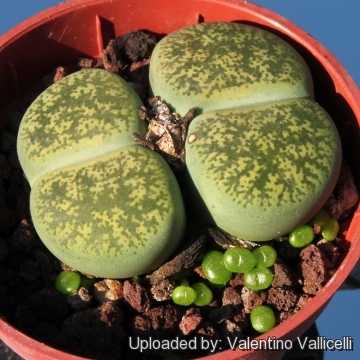 Lithops lesliei f. albinica (Lithops lesliei C036A TL: Near Warrenton, South Africa cv. albinica) Photo by: Valentino Vallicelli
Lithops lesliei f. albinica (Lithops lesliei C036A TL: Near Warrenton, South Africa cv. albinica) Photo by: Valentino Vallicelli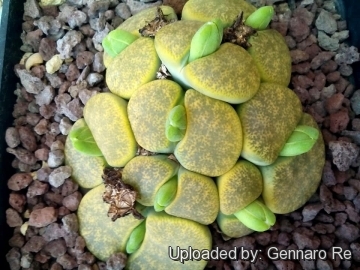 Lithops lesliei f. albinica (Lithops lesliei C036A TL: Near Warrenton, South Africa cv. albinica) Photo by: Gennaro Re
Lithops lesliei f. albinica (Lithops lesliei C036A TL: Near Warrenton, South Africa cv. albinica) Photo by: Gennaro Re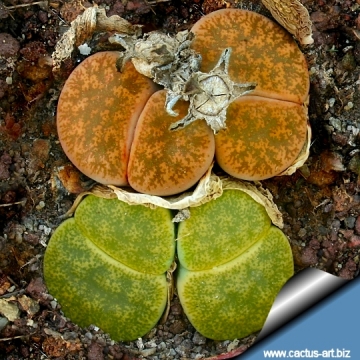 Lithops lesliei f. albinica (Lithops lesliei C036A TL: Near Warrenton, South Africa cv. albinica) Photo by: Cactus Art
Lithops lesliei f. albinica (Lithops lesliei C036A TL: Near Warrenton, South Africa cv. albinica) Photo by: Cactus ArtCultivation and Propagation: L. lesliei is a summer growing species with dry rest period over winter. Easy to grow it tolerates a degree more excess water than some particular hydrophobic species, even so it must have a very open mineral, fast draining mix with little compost and a hight degree of grit, coarse sand, small lava gravel or pebbles. Give them the maximum amount of light you are able to give them, but care should be taken about exposing them to the full blast of the sun rays in summer. Such tiny plants can easily get scorched or broiled and their appearance spoiled (this may not matter in the wild, where the Lithops have probably shrunk into the ground and becomes covered with sands).
The basic cultivation routine is: Stop watering after flowering. Start watering after the old leaves completely dry. (Usually late March or Early April) Water freely during the growing season, soak the compost fully but allow it to dry out between waterings, no water when cold. Some growers fertilize frequently, some hardly ever. Keep them dry during the winter. Nearly all problems occur as a result of overwatering and poor ventilation especially when weather conditions are dull and cool or very humid. If too much water is supplied the plants will grow out of character, bloat, split and rot. Keep them in small pots as solitary clumps or as colonies in large, shallow terracotta seed pans.
Note: After flowering in the autumn and extending through winter season the plant doesn’t need watering, but they will still be growing, the new bodies will be increasing in size extracting water from the outer succulent leaves, allowing them to shrivel away. In fact the plant in this time extracts water and nutrient stored in the outer succulent leaves, allowing them to dehydrate relocating the water to the rest of the plant and to the new leaves that form during this period until the old leaves are reduced to nothing more than "thin papery shells".
Your Photos

by Cactus Art
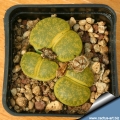
by Cactus Art

by Valentino Vallicelli
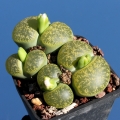
by Valentino Vallicelli

by Valentino Vallicelli























